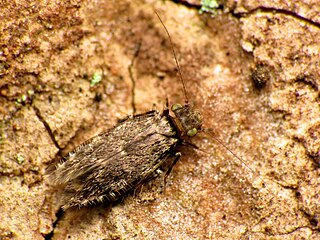
Trogiomorpha is one of the three major suborders of barklice, booklice, and parasitic lice in the order Psocodea, alongside Troctomorpha and Psocomorpha. There are about 8 families and more than 430 described species in Trogiomorpha. Trogiomorpha is widely agreed to be the earliest diverging of the three suborders, and retains the most primitive characteristics.

Troctomorpha is one of the three major suborders of Psocodea (barklice, booklice, and parasitic lice), alongside Psocomorpha and Trogiomorpha. There are more than 30 families and 5,800 described species in Troctomorpha. The order includes parasitic lice, which are most closely related to the booklice family Liposcelididae.

Psocidae is a family of barklice in the order Psocodea.

Myopsocidae is a family of mouse-like barklice, belonging to the infraorder Psocetae of the order Psocodea. This family is closely related to Psocidae, with which it shares similar wing-venation, but from which it is distinguished by three-segmented tarsi.
Pachytroctidae is a family of thick barklice in the order Psocodea. There are about 15 genera and at least 90 described species in Pachytroctidae.
Asiopsocidae is a family of Psocodea belonging to the infraorder Caeciliusetae. The family is composed of 14 known species of barklice in three genera: Asiopsocus, Notiopsocus, and Pronotiopsocus. One species from each genus has been found in the United States.

Ectopsocidae is a family of Psocodea belonging to the suborder Psocomorpha. The family includes fewer than 200 species, most of them in the genus Ectopsocus.
Elipsocidae is a family of Psocodea belonging to the infraorder Homilopsocidea. Members of the family have a free areola postica. Many species are apterous. The family includes about 130 species in more than 30 genera.
Psilopsocidae is a family of Psocodea belonging to the infraorder Psocetae. Members of the family have a free areola postica and mottled wings. It is the only psocopteran family with records of wood-boring species. The family comprises one genus and seven species.

Caeciliusidae is a family of Psocodea belonging to the suborder Psocomorpha. The family was once named Caeciliidae, but the latter name was changed because of homonymy with the amphibian family Caeciliidae. The subfamily Paracaeciliinae was formerly in Caeciliusidae, but it has been elevated to family rank, Paracaeciliidae.
Prionoglarididae is a family of the order Psocodea that are barklice characterized by the reduction or simplification of the lacinia in adults and the specialised form of the male genitalia. It contains the only known genus of animals, Neotrogla, where females possess a penis-like organ and take on typical male sex roles.

Neotrogla is a genus of barklice noted for its reversed sex roles and organs, traits shared by all species of the genus.

Lepidopsocidae are an insect family of bark lice belonging to the suborder Trogiomorpha. Colloquially, Lepidopsocidae are referred to as the Scaly-winged Barklice. There are more than 220 species described worldwide. Phylogenetic DNA analysis of relationships between families in Trogiomorpha propose that Lepidopsocidae is monophyletic, meaning that the taxa within all share a common ancestor. This is supported morphologically by the presence of scales and setae covering the body and forewings of Lepodopsocids. Sister families of Lepidoposcidae include Trogiidae and Psoquillidae.
Soa is a genus of scaly-winged barklice in the family Lepidopsocidae. There are about six described species in Soa.

Trogiidae is a family of granary booklice in the order Psocodea. There are about 11 genera and more than 50 described species in Trogiidae.

Cerobasis is a genus of granary booklice in the family Trogiidae. There are at least 30 described species in Cerobasis.

Amphientometae is an infraorder of psocids, one of two major division of the Troctomorpha within the order Psocodea. There are about 7 families and at least 230 described species in Amphientometae.
Afrotrogla is an African genus of large-winged psocids in the family Prionoglarididae, discovered and described by Charles Lienhard. There are three described species in Afrotrogla, all found in certain caves of Namibia.
Sensitibilla is an African genus of large-winged psocids in the family Prionoglarididae, discovered and described by Charles Lienhard. It contains four species.
Siamoglaris is a genus of psocids in the family Prionoglarididae, the only one in the Indomalayan realm.








